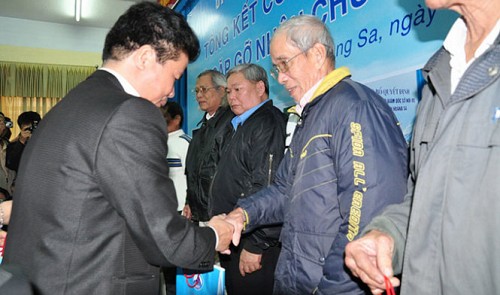Hoang Sa - a part of flesh and blood of Viet Nam
An old Vietnamese man has said that he feels anxious whenever he hears the words “Hoang Sa” (Paracel) and hopes future Vietnamese generations will do their best to reclaim the archipelago, which is an inseparable ‘blood and flesh’ part of the fatherland.
Mr Vo Nhu Dan, 78, a resident of Da Nang's Hai Chau District made the statement at an annual gathering of people who are considered “witnesses” of Viet Nam’s sovereignty over the Hoang Sa archipelago in the Bien Dong (East Viet Nam Sea).
The gathering was held by the People’s Committee of the city’s Hoang Sa Island District on January 19, on which 41 years ago China used force to illegally occupy the islands.
Mr Dan said this year’s gathering was sadder than the previous events, as more and more “witnesses” have passed away.
There used to be 14 “witnesses” at the previous gatherings, but the number was reduced to 10 yesterday, as four of the 14 people have passed away due to illness, Mr Dan said.
Mr Dan added he worked at a hydro-meteorological station in Hoang Sa from 1956 to 1968, noting that he was among the people who spent the most time in the archipelago.
 |
| Chairman of the Hoang Sa Island District People's Committee Vo Cong Chanh (L), presents gifts to the "witnesses" of Viet Nam's sovereignty over the Hoang Sa (Paracel) archipelago at a gathering held in Da Nang on January 19. |
“Until now, I still well remember trees, grassland, and golden sand dunes out there. Whenever I hear the words ‘Hoang Sa,’ I feel anxious. My generation is coming to an end. I hope future generations will try their best to reclaim the archipelago, which is an inseparable ‘blood and flesh’ part of the fatherland,” Mr Dan said.
He added he is suffering from rheumatism but he will continue doing his utmost to attend the annual gathering.
Another “witness” at the event was Mr Ngo Van Cuc, a former soldier of the Republic of Viet Nam, which existed before 1975, who was among the Vietnamese fighters to take part in combat in Hoang Sa against Chinese forces that have illegally occupied the archipelago since January 19, 1974.
In that unequal fight, Mr Cuc was seized as a prisoner by the Chinese and later released back to Viet Nam, he said.
In talking with participants at the gathering, Mr Cuc said, “On behalf of my companions-in-arms in Hoang Sa that day, I would like to reiterate that the archipelago belongs to Viet Nam. We must always remember that Hoang Sa belongs to us.”
Speaking at the gathering, Mr Vo Cong Chanh, chairman of the People's Committee of Hoang Sa Island District, said that local authorities will begin the construction of a display structure dedicated to Hoang Sa on April 30, 2015.
He added that many activities related to the protection of Viet Nam’s sovereignty over its seas and islands will also be conducted this year.
Mr Bui Van Tieng, chairman of the Da Nang Historical Science Association, told the gathering that during China’s illegal deployment of its Haiyang Shiyou 981 drilling rig in Vietnamese waters from early May to July 16, 2014, people in Da Nang, along with others nationwide, voiced their strong protest against such an act of invasion and showed great patriotism.
Such patriotism has been strongly expressed by young people through their enthusiastic participation in a letter-writing contest, “Writing on the Beloved Hoang Sa,” which concluded in December 2014, Tieng said. As many as 87,701 letters were sent to the contest’s organizing board, he added.
Mr Trinh Van Quy, one of the soldiers stationed on Huu Nhat Island, part of the Hoang Sa archipelago, in January 1974, said, “Until now, we still do not forget an image in which a natural coral reef emerges from the blue sea… On the reef, nhàu [noni] and gai [ramie] plants grow densely and form circles like walls to protect the island.”
At that time, there were many traces left by Vietnamese people who had lived on the island, and there were also objects left by Vietnamese fishermen who had visited the place, Mr Quy said.
Notably, there remained fortifications dug by Vietnamese soldiers who had been stationed on the island previously, he recounted.
The ex-soldier also said January 1974 marked his last days in Hoang Sa before China used force to illegally occupy the archipelago.
After returning to the mainland from Hoang Sa, Mr Quy, holding his little daughter in his arm, burned incense to pay tribute to his companions-in-arms who perished while protecting the territory.
During that moment of commemoration, Mr Quy told himself that he would name his daughter “Trinh Thi Hoang Sa” as homage to Hoang Sa and as a message to following generations that the group of islands is an integral part of Viet Nam.
A requiem for the combatants who perished while defending Hoang Sa against Chinese forces was held on Ly Son Island, administered by the Quang Ngai Province, on May 23-25, 2014.